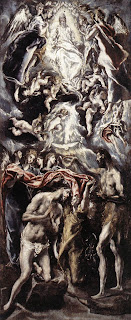 Picasso, Nude on a Black Couch, 1932, Oil on canvas, 162 x 130cm
Picasso, Nude on a Black Couch, 1932, Oil on canvas, 162 x 130cmPicasso's Nude on a Black Couch is a masterpiece for me. This painting is highly erotic. You can almost hear the voluptuous girl in a state of complete undressed and holding a virgin white calla lily lazily unfurling herself in sheer comfort on a sensual black velvet couch. Are the eagerly philodendron leaves unfolding and sprouting around her a symbol of her fertility or are they waiting for the opportunity to caress her?
The girl is supposingly Marie Therese, Picasso's mistress. Picasso was 51 and she 18 before they started a 30 years tempestous affair.
The highly pleasing colour composition and erotically charged meaning behind the painting makes this a coveted piece worthy of any playboy's penthouses. It would be most wonderful if this painting ever gets a chance to be view by the public.







